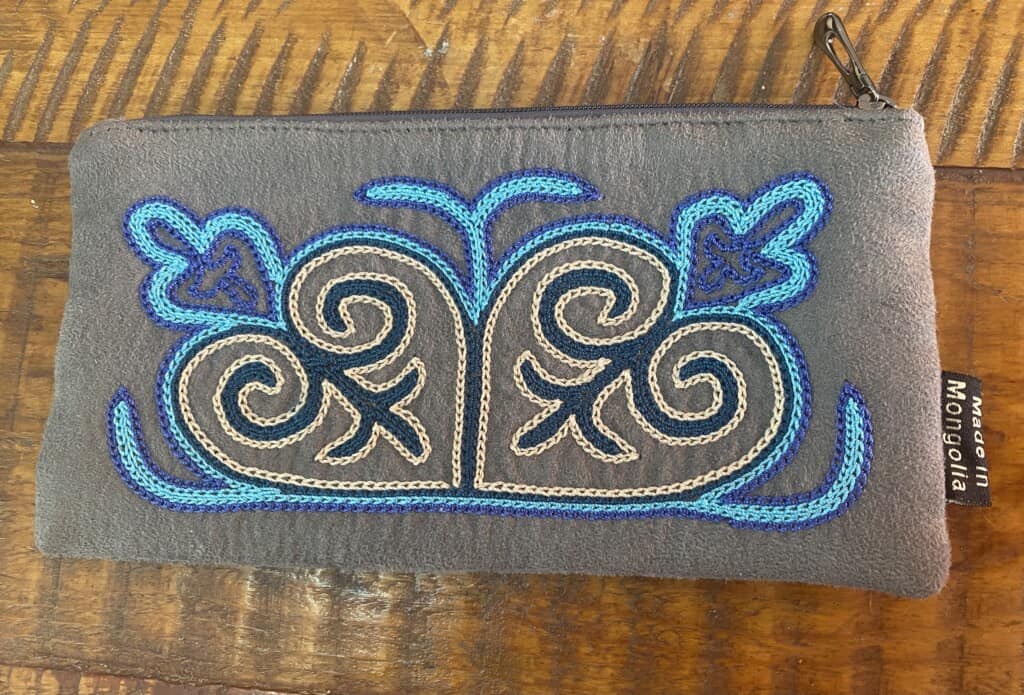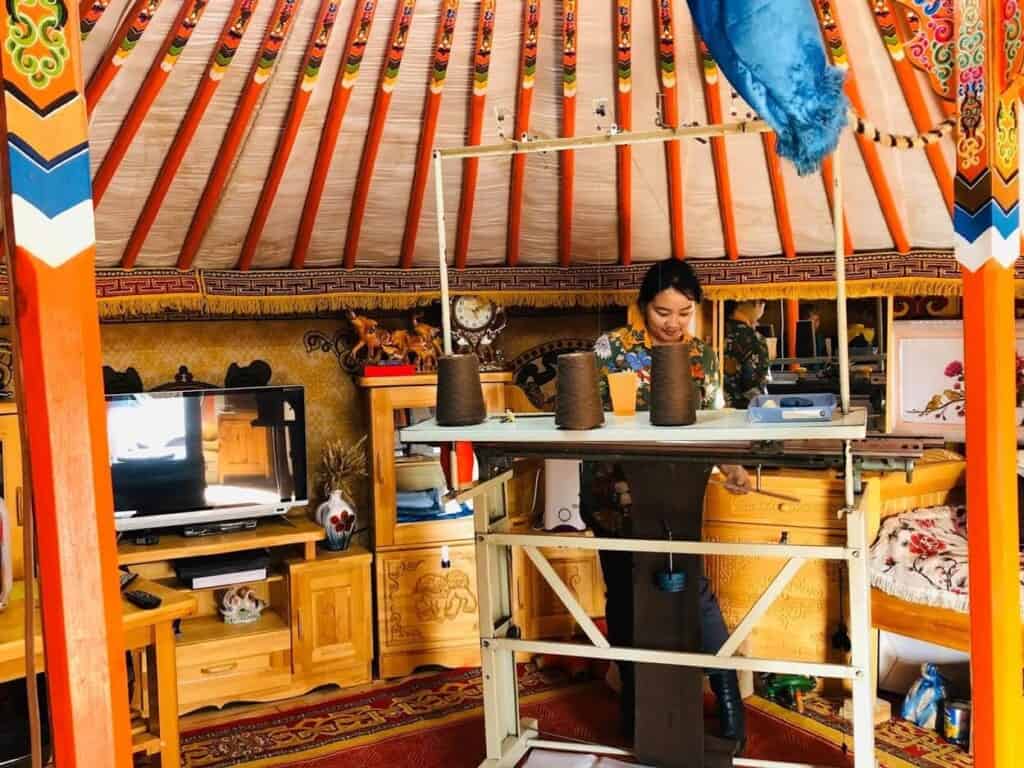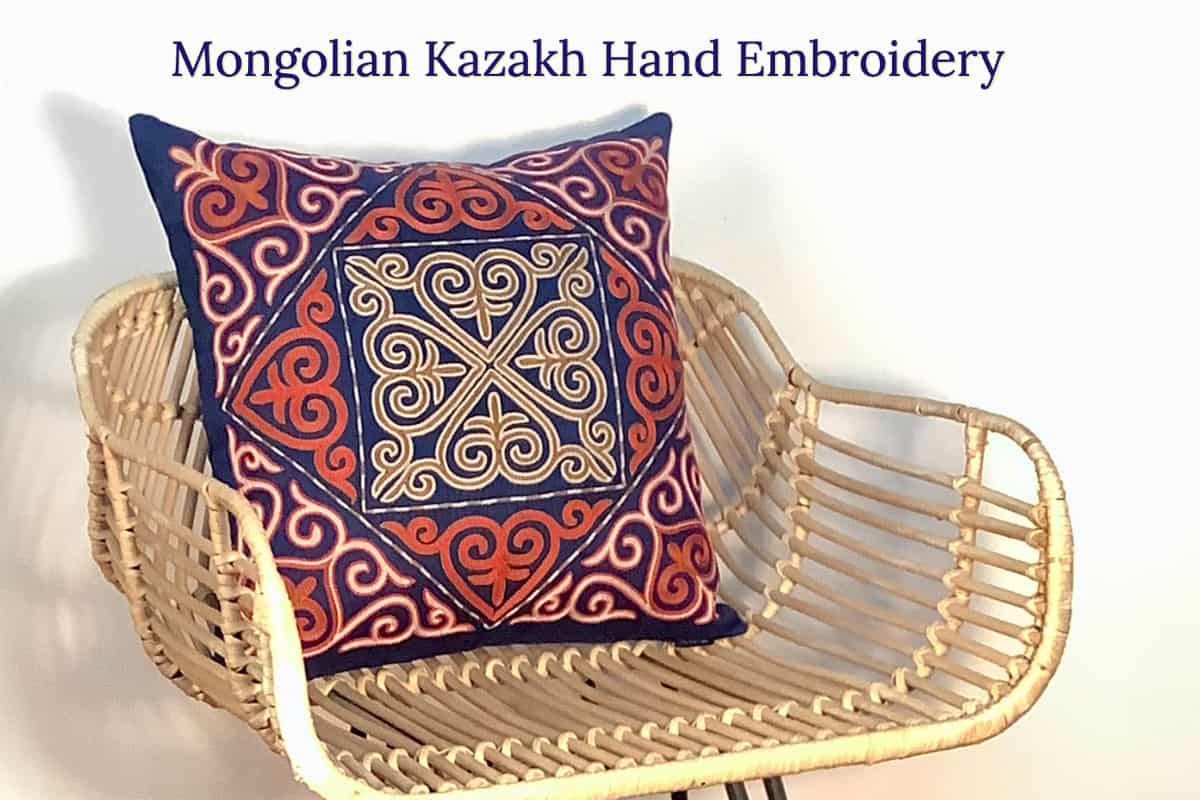Hand embroidery has been a handicraft in the world’s cultures and traditions for thousands of years. Hand embroidery is used in fashion, textiles, and home decor accessories.
Hand embroidery is the handicraft of using fabric and other materials with a needle and thread to place a design on a textile or fabric. For a textile or fabric to be considered hand embroidered, it should be just that 100% embroidered by hand. In the Kazakh part of Western Mongolia, the women have kept the skill of 100% hand embroidery alive.
Table of Contents
Hand Embroidery Defined
Hand embroidery is the handicraft of using fabric and other materials with a needle and thread or yarn to place a design on textile, fabric, or other materials. Hand embroidery can use various thread or yarn types and colors with other materials such as pearls, beads, quills, and sequins.
Fifteen basic types of hand embroidery stitches include: 1) backstitch, 2) running stitch, 3) straight stitch, 4) french knot, 5) stem stitch, 6) chain stitch, 7) satin stitch, 8) feather stitch, 9) detached chain stitch, 10) fly stitch, 11) woven wheel stitch, 12) couching stitch, 13) split stitch 14) bullion knot and 15) blanket stitch. Even though these are the major hand embroidery stitches, any stitch that uses a needle, thread, textile, or another material to make a design is considered hand embroidery.

Embroidery, especially hand embroidery, has been around for a long time. The art of embroidery is found worldwide. Several examples have been found in China dating back to the third century BC. Other garments have been found in Sweden that date back between 300 to 700 A.D. These may use different types of stitches but show that the handicraft skill of embroidery has been around for a long time.
It can be said that embroidery is one skill that can still be found throughout the world. Almost every culture has some form of hand embroidery.
Due to economics or efficiency, a lot of hand embroidery has been replaced with machine embroidery. Today, many of these machine embroideries are so good that it’s tough to tell the difference between hand and machine embroidery items.
Hand Embroidery Vs. Embroidery Machines
Embroidery machines have been around since the early 1800s. Nearly 20 years before Isaac Singer patented the first sewing machine in 1846, the Frenchman Josue Heilman invented the first known embroidery machine.
Heilmann’s embroidery machine was revolutionary for its time. This machine consisted of a frame to hold the fabric and a needle and thread; instead of taking the needle to the fabric, the fabric would move to meet the needle. This allowed the embroidery to go in any direction on the fabric.
In the early 1800s, this invention was viewed as a threat to hand embroiderers because Heilmann only sold two machines. The technology that Heilmann developed is the foundation for today’s modern-day embroidery machines.
For us to consider an item 100% hand embroidered, it should be just that – 100% embroidered by hand. For example, if an embroidery machine and some hand embroidery were both used to embroider a product, we do not consider this item a 100% hand-embroidered product as part of the embroidery was done by a machine and part by hand,

Mongolian Kazakh 100% Hand Embroidery
One area of the world that has consistently kept up its 100% hand embroidery skills is in Kazakhstan part or western part of Mongolian. The people in this area from west Mongolia are known as the Kazakh people. They are the largest ethnic group in Mongolia, with over 100,000 people considering themselves Kazakh; this is about 4% of the total Mongolian population.
The Mongolian Kazakhs are culturally and ethnically very different from the Mongolians. The Kazakhs speak a different language and practice a different religion. Many of Mongolia’s Kazakh people are practicing Muslims; a majority of Mongolians are Tibetan Buddhists. Kazakhstan and Mongolia do not even share a common border; about 47 to 60 km (29- 41 miles) of a mountainous stretch separates Kazakhstan and Mongolia, with a small part of Russian and Chinese borders separating them.
Despite this separation, the Mongolian Kazakh people share a lot of the same culture and traditions as Kazakhstan. One of those cultural traditions is the art and skill of 100% hand embroidery.
It can be said that many of these Mongolian Kazakh people kept the embroidery tradition more alive than their Kazakh neighbors. One of the reasons was that Kazakhstan was part of the Soviet Union and Mongolia was a socialist country.
Mongolia allowed the Kazakh people to continue to live their lives in western Mongolia as they had for centuries; this included allowing the Kazakh Mongolians to keep their cultures and handicrafts alive as their hand embroidery handicrafts. If you would like to learn more about Mongolia, you can read the blog How Long Has Mongolia Been A Country? by clicking here.
Some of the Kazakh people have left their homes in western Mongolia and have moved to Mongolia’s capital city of Ulaanbaatar; these Kazakh people have brought their handicraft skills with their embroidery. Many women have set up hand embroidery workshops in their homes or gers (yurts) to make products and other things to sell locally and export.

These Mongolian Kazakh women’s hand embroidery skills are so refined that when I saw their handiwork, I was sure it was machine embroidered and not 100% handmade; their hand stitching was so uniform and perfect. It was only upon a much closer examination that I saw that the stitching was 100% hand embroidered.
These Kazakh women are extremely fine hand embroiderers. They perform the hand embroidery chain stitch with exact precision.
At Mondoro, we love to help these high-skilled women keep their handicrafts alive; this hand embroidery business allows them to stay home and use their handicraft skills to earn an income to support their families. We love and appreciate this kind of handicraft work to help these women earn an income while caring for their families.
If you are interested in developing some 100% hand-embroidered products with Mongolian Kazakh women, please feel free to contact Anita at Mondoro. You can contact Anita by clicking here or contacting her at sales@mondoro.com. We would love to hear from you and help you develop some export quality 100% hand-embroidered products with these highly skilled and richly deserving Mongolian Kazakh women embroidered.
Find out more about how Mondoro can help you create, develop, and manufacture excellent home decor and furniture products – don’t hesitate to contact me, Anita. Check out my email by clicking here or become a part of our community and join our newsletter by clicking here.
Mondoro gives out a FREE Lookbook to anyone interested. You can receive a copy of our latest Lookbook by clicking here.
Listen to our Podcast called Global Trade Gal. You can find it on all major podcast platforms. Try out listening to one of our podcasts by clicking here.
Subscribe to our Mondoro Company Limited YouTube Channel with great videos and information by clicking here.
Related Questions
What About Mongolian Cashmere Fibers, Yarns, and Products?
Mongolia has the largest global share in trading animal hair products and the second-largest world producer of cashmere. The reason is that Mongolian goats grow a lot of long, soft, fine hair, in part due to the harshness of the winter weather in Mongolia. The same goats also produce some wonderful organic colors of cashmere that is only found in Mongolia. Because of the length of the cashmere fibers, the finest of the fibers themselves, this ensures that Mongolia is a top spot in the world for the production of fine cashmere.
You can learn more by reading our blog 11 Facts About Mongolian Cashmere Fibers, Yarns, and Products, by clicking here.
What Is The Difference Between Earthenware, Stoneware, and Porcelain?
Earthenware, stoneware, and porcelain are all made by various clays and then fired. The kind of clay used and the temperature at which they are fired can make a difference as to how soft or hard the actual end product is. Though they all seem to be similar, they are all very different materials and products.
You can learn more by reading our blog Earthenware, Stoneware, and Porcelain Materials by clicking here.

